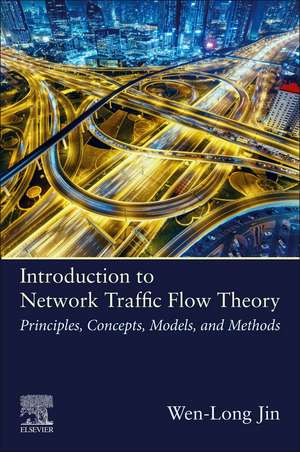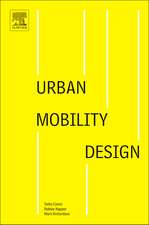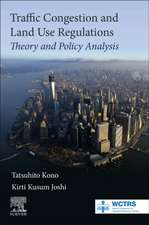Introduction to Network Traffic Flow Theory: Principles, Concepts, Models, and Methods
Autor Wen-Long Jinen Limba Engleză Paperback – 19 apr 2021
Users wills find this to be a great resource on both theory and applications across a wide swath of subjects, including road networks and reduced traffic congestion.
- Covers the most theoretically and practically relevant network traffic flow theories
- Provides a systematic introduction to traditional and recently developed models, including cell transmission, link transmission, link queue, point queue, macroscopic and microscopic models, junction models and network stationary states
- Applies modern network traffic flow theory to real-world applications in modeling, analysis, estimation, control, management and planning
Preț: 571.49 lei
Preț vechi: 732.96 lei
-22% Nou
Puncte Express: 857
Preț estimativ în valută:
109.36€ • 116.94$ • 91.18£
109.36€ • 116.94$ • 91.18£
Carte tipărită la comandă
Livrare economică 11-25 aprilie
Preluare comenzi: 021 569.72.76
Specificații
ISBN-13: 9780128158401
ISBN-10: 0128158409
Pagini: 282
Dimensiuni: 152 x 229 x 20 mm
Greutate: 0.38 kg
Editura: ELSEVIER SCIENCE
ISBN-10: 0128158409
Pagini: 282
Dimensiuni: 152 x 229 x 20 mm
Greutate: 0.38 kg
Editura: ELSEVIER SCIENCE
Public țintă
1) Academic researchers and graduate students in transportation modeling, planning and systems 2) Transportation practitioners involved in planning, feasibility studies, consultation and policy for transportation systems or infrastructure, 3) Transportation public officials such as city managers, policy directors, etc.Cuprins
Part I. Basics
1. Introduction
2. Representations, variables, and observations
3. Fundamental diagrams
Part II. Link Models
4. The Lighthill-Whitham-Richards model
5. The Cell Transmission Model
6. The Link Transmission Model
7. Queueing models
Part III. Network Models
8. Junction models
9. Network kinematic wave theory
10. Network stationary states and stability
11. Capacity drop models
Part IV. Microscopic models
12. Equivalence between continuum and car-following models
13. Second-order formulation of the LWR model
14. Bounded acceleration models
15. Multilane car-following models
16. Second-order capacity drop model
17. Appendix
1. Introduction
2. Representations, variables, and observations
3. Fundamental diagrams
Part II. Link Models
4. The Lighthill-Whitham-Richards model
5. The Cell Transmission Model
6. The Link Transmission Model
7. Queueing models
Part III. Network Models
8. Junction models
9. Network kinematic wave theory
10. Network stationary states and stability
11. Capacity drop models
Part IV. Microscopic models
12. Equivalence between continuum and car-following models
13. Second-order formulation of the LWR model
14. Bounded acceleration models
15. Multilane car-following models
16. Second-order capacity drop model
17. Appendix
















